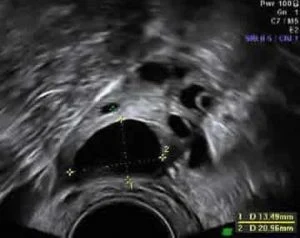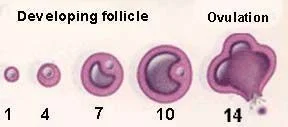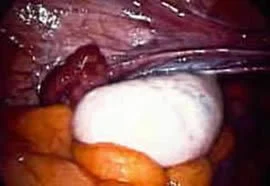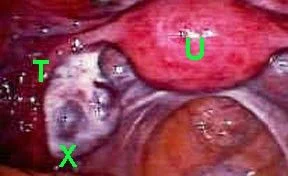Infertility due to ovulation problems, also known as anovulation, occurs when a woman's body does not release an egg during her menstrual cycle. A common cause of anovulation is polycystic ovarian syndrome (PCOS), a condition that can disrupt regular ovulation and lead to fertility challenges.
Background on normal ovulation
- The egg lives in an ovarian follicle until it is released at the time of ovulation
- As a follicle grows in size during a menstrual cycle a fluid cavity enlarges in it
- The egg is attached to the follicle wall
- Ovulation is the process of rupture of the mature follicle and release of the egg
- The fallopian tube is then supposed to pick up the egg and, if all goes well, the sperm and egg have a productive date in the woman’s fallopian tube
Ultrasound picture of a polycystic ovary. Many small, immature follicles (black circles) are seen. These follicles are less than 10mm in diameter. The follicles are not growing to a mature size
Normal ovary with a mature follicle. Yellow cursors are measuring the mature follicle. Fluid in the follicle is black on ultrasound. Follicle is 18mm diameter – about ready for ovulation
In an average 28 day menstrual cycle, ovulation usually occurs on day 14, with day 1 being the first day of menstrual bleeding. If a woman has cycle lengths that are shorter or longer than 28 days, then the day of ovulation will usually be 14 days before her next period. So if she has a 26 day cycle length, then her ovulation should be on about day 12 and if she has a 32 day cycle, the ovulation is about day 18.
The length of time it takes a follicle to mature and ovulate is somewhat variable in different women (and in different cycles in the same woman), but the number of days from ovulation to the next period is much less variable and should be close to 14 days in everyone.
Menstrual Cycle
Developing follicle during a 28 day cycle with ovulation on day 14 Menstrual cycle days are shown at the bottom
- Some women do not properly develop and release a mature egg every month – they do not ovulate regularly. We call this anovulation (lack of ovulation) – or oligoovulation (infrequent or irregular ovulation).
Some women never develop and release an egg without medication – we say they are anovulatory. These women have no menstrual periods for several months or years at a time. The medical term for this is amenorrhea – lack of menstrual periods. Often, when they do have a period it is quite heavy. In some cases, they may even require medical attention because of the degree of blood loss.
- Some women ovulate occasionally (oligoovulation), for example, several times a year. They will often need medication to stimulate more regular egg development and ovulation to increase the chances for pregnancy.
Diagnostic testing for ovulation disorders
Usually the doctor can tell from discussing the details regarding previous menstrual cycles whether there is likely to be an ovulation disorder. In addition, blood testing and ultrasound studies of the ovaries at various times of the menstrual cycle can clarify whether ovulation is occurring.
Polycystic ovarian syndrome, PCOS
Polycystic ovarian syndrome is a very common cause of anovulation, or oligoovulation and infertility.
Laparoscopic image of an enlarged, polycystic ovary. No mature follicle seen.
Picture of a normal ovary close to ovulation. Mature follicle seen above the X (looks like a blister) U= uterus, T = tube
Treatment of ovulation problems and polycystic ovaries
In general, cumulative pregnancy success rates are high with treatment from a fertility specialist when the fertility issue is an ovulation problem.
If the female age is under about 37, it is usually more a matter of which fertility medications and treatments will end up being successful – rather than whether anything will ever work.






